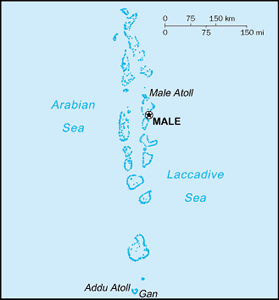The Geography of Maldives
The Geography of Maldives
Maldivian Geography
Location: Southern Asia, group of atolls in the Indian Ocean, south-southwest of India
Geographic coordinates: 3 15 N, 73 00 E
Map references: Asia
Area: total: 300 sq km land: 300 sq km water: 0 sq km
Area - comparative: about 1.7 times the size of Washington, DC
Land boundaries: 0 km
Coastline: 644 km
Maritime claims: measured from claimed archipelagic straight baselines territorial sea: 12 nm contiguous zone: 24 nm exclusive economic zone: 200 nm
Climate: tropical; hot, humid; dry, northeast monsoon (November to March); rainy, southwest monsoon (June to August)
Terrain: flat, with white sandy beaches
Elevation extremes: lowest point: Indian Ocean 0 m highest point: unnamed location on Wilingili island in the Addu Atoll 2.4 m
Natural resources: fish
Land use: arable land: 13.33% permanent crops: 30% other: 56.67% (2005)
Irrigated land: NA
Natural hazards: low level of islands makes them sensitive to sea level rise
Environment - current issues: depletion of freshwater aquifers threatens water supplies; global warming and sea level rise; coral reef bleaching
Environment - international agreements: party to: Biodiversity, Climate Change, Climate Change-Kyoto Protocol, Desertification, Hazardous Wastes, Law of the Sea, Ozone Layer Protection, Ship Pollution signed, but not ratified: none of the selected agreements
Geography - note: 1,190 coral islands grouped into 26 atolls (200 inhabited islands, plus 80 islands with tourist resorts); archipelago with strategic location astride and along major sea lanes in Indian Ocean


